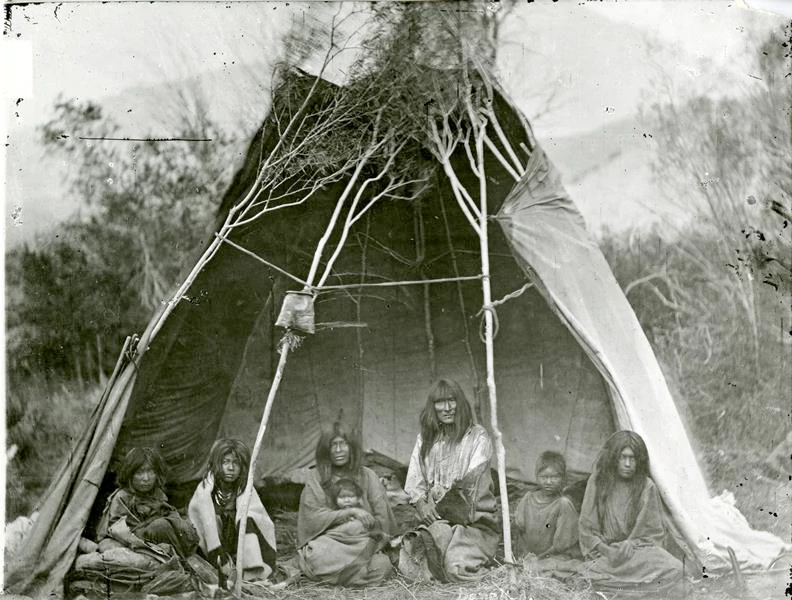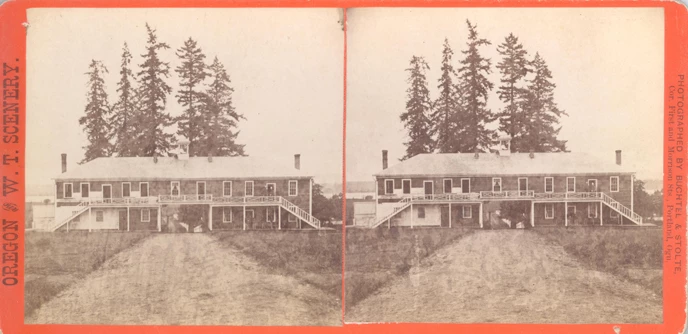Part of a series of articles titled Vancouver Barracks in the 1880s.
Article
Vancouver Barracks in the 1880s: Incarceration of the Tukudika

Courtesy of National Park Service, Yellowstone National Park, YELL 8151
"Home is where the heart is." "There's no place like home." "Home, sweet home."
We all know what it's like to feel attached to - or long for - home. We can imagine how it would feel to be separated from the place where we feel most comfortable.
In the 1870s and 1880s, Vancouver Barracks supported military actions against Native American peoples throughout the Northwest. Here, wars against Native peoples were planned, and those who were captured were brought to the Vancouver Barracks Guardhouse as prisoners. Specifically, Nimiipuu (Nez Perce), Yakama, Bannock, and Tukudika, the "Sheepeater" band of Shoshone, were imprisoned here and were often only released once they agreed to be relocated from their ancestral homelands to reservations. In addition, important tribal leaders were held here as a tactic to manipulate their people into agreeing to move to reservations.
In the late 1870s, Tukudika in the Columbia Plateau region were accused of attacking American settlers and miners, who insisted that the US Army remove Indigenous peoples to reservations. After a decisive battle on October 1, 1879, a surrendering group of Tukudika was forced on a difficult 62-day march from Idaho to Vancouver. Nine months later, these 50 individuals, a group that included men, women, and children, were recorded on the United States census as "Indian Prisoners" at Vancouver Barracks.
We all know what it's like to feel attached to - or long for - home. We can imagine how it would feel to be separated from the place where we feel most comfortable.
In the 1870s and 1880s, Vancouver Barracks supported military actions against Native American peoples throughout the Northwest. Here, wars against Native peoples were planned, and those who were captured were brought to the Vancouver Barracks Guardhouse as prisoners. Specifically, Nimiipuu (Nez Perce), Yakama, Bannock, and Tukudika, the "Sheepeater" band of Shoshone, were imprisoned here and were often only released once they agreed to be relocated from their ancestral homelands to reservations. In addition, important tribal leaders were held here as a tactic to manipulate their people into agreeing to move to reservations.
In the late 1870s, Tukudika in the Columbia Plateau region were accused of attacking American settlers and miners, who insisted that the US Army remove Indigenous peoples to reservations. After a decisive battle on October 1, 1879, a surrendering group of Tukudika was forced on a difficult 62-day march from Idaho to Vancouver. Nine months later, these 50 individuals, a group that included men, women, and children, were recorded on the United States census as "Indian Prisoners" at Vancouver Barracks.

NPS Photo, Fort Vancouver National Historic Site
Prisoners lived in the Guardhouse, which stood opposite the Grant House (then an officers' residence) and the Parade Ground flagpole. Male prisoners were forced to make improvements to the military post. They built roads and painted fences. Children were made to attend school and learn English. Women had to attend sewing classes led by officers' wives. During their incarceration here, two men escaped and fled across the Columbia River.
In 1881, the Tukudika at Vancouver Barracks, who had been separated from their homes in central Idaho, were escorted to the Fort Hall Reservation in southeastern Idaho, where many of their descendants still live today.
In 1881, the Tukudika at Vancouver Barracks, who had been separated from their homes in central Idaho, were escorted to the Fort Hall Reservation in southeastern Idaho, where many of their descendants still live today.
Last updated: July 1, 2021
